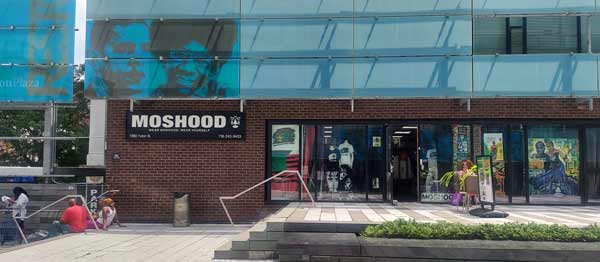By Nayaba Arinde
Editor at Large
When some folks rolled up to Bed Stuy’s Restoration Plaza this week, they were surprised to see all doors locked, bright red chairs removed, signage taken down, and a notice stating “End of Our Lease” on the doors of Applebee’s.
The rumor mill went into overdrive. Is the Post Office closing? Will Moshood’s Creations fashion store remain? What about Carver Bank and Foodtown?
Chase was their anchor tenant, but left last year, replaced eventually by the Brooklyn Cooperative Credit Union.
This, just a couple of years after news first broke that the whole Plaza was going to be torn down, and rebuilt into two multi-million-dollar multi-story commercial, art, business and tech hubs.
“Recently, we have received inquiries pertaining to the closure of Applebee’s at Restoration Plaza and questions around other potential tenant vacancies,” Renée D. Jenkins, Chief Advancement Officer of Bedford Stuyvesant Restoration Corporation, told Our Time Press.
“Restoration respects the decision of all its tenants who may elect not to renew their lease and appreciates the years-long partnerships with these businesses, which have helped the local economy and created jobs for many local residents.”
While there are no signs of large-scale moving or deconstruction, in 2023, Restoration revealed developers’ plans to renovate the Fulton Street/Harriet Ross Tubman Avenue space into the “Restoration Innovation Campus, a global hub dedicated to closing Brooklyn’s racial wealth gap.”

This past Saturday, Restoration Plaza-located Moshood Afariogun held his mega 31st annual fashion show. In attendance with his family, Public Advocate Jumaane Williams told Our Time Press, “We need Restoration to remain this community-centered space. It was the first Community Development Corporation in the country, and there is still very much a need for it.
It is a central part of this neighborhood. I hope that whatever the plans are for this historic space, it remains one that the community has access to, and stays the vibrant venue that has hosted so many great events. And we will definitely look into it to ensure that the community is kept informed about the future of Restoration Plaza.”
Always a man of few words, Moshood himself told the paper, “We have not been told too much at all, but we are staying.”
A worker behind the counter at the Post Office assured Our Time Press, “We are not going anywhere. There are no plans to close this location.”
“Renovating or reimagining, we need to make sure we keep the Restoration Plaza. It is the first Community Development Corporation in the country,” Assemblywoman Stefani Zinnerman told Our Time Press. “And while everyone keeps going on about Robert Kennedy, John Lindsay, and Jacob Javits, I must mention Elsie Richardson–the community activist who advocated to bring this about, and the fantastic programming that we continue to have here.
“Restoration is too big to fail,” continued the Bed Stuy Assemblywoman. “It cannot be replaced. There are so many investors, like myself, who are waiting to invest in this space. I have very solid plans for the community.”
Created in 1967 through solid grassroots activism and the bipartisan alliance of Senators Kennedy and Javits, Restoration said their mission is, “To close the racial wealth gap in Central Brooklyn’s lower income neighborhoods through an economic mobility platform designed to help people become financially literate and independent.”
In 2023 Restoration announced that they were planning to use the mixed-use 840,000-square-foot space to “enable Restoration to meet the needs of the community.”
While currently on vacation, Restoration Corporation president and CEO Blondel Pinnock said that to maximize the current space, the plan was to build a 16-story, 245-foot-high building, a 195-foot, 13-story building, and a four-story building. These would guarantee spots for existing tenants and commercial space for new entities and organizations, including cultural spaces, dance studios, and art galleries.
For 5 decades, they say that every year they serve more than 60,000 people. Pinnock said on the website, “Restoration has helped lift thousands of local residents out of poverty and created countless opportunities right here in our community.
Now, the nation’s staggering racial wealth gap requires a bold, new approach—to harness Brooklyn’s economic growth to support wealth creation for our neighbors, particularly longtime residents and people of color. We look forward to working with local elected leaders and the residents we’ve proudly served for generations to realize this critical vision.”
“They are going through such a tumultuous time,” a source close to Restoration Plaza told Our Time Press, preferring to remain anonymous. “They are tearing everything down and moving the office to New York Avenue. Everything else, and the stores at 1368, will have to go.
This was a plan from 15 years ago, when they met with the community and with the architect. But everything is a secret now. They don’t understand that they have had a responsibility to the community for over 50 years, and now you’re not telling anyone?”
Heavily gentrified now, in what used to be one of the nation’s biggest African American communities, yet, do-or-die Bed Stuy still manages to maintain that overall Black Brooklyn energy.
The beloved gathering place for the community, Restoration, has helped maintain that defiant character.
It used to be a milk bottling plant, but Restoration opened in 1972 to become a busy business, education, and cultural event space, a meeting hall, an education and edutainment locale, an outside movie theater, jazz, hip hop, calypso and soul spot, and an interactive art locale – with both the Skylight, and director Eric Edwards’ Cultural Museum of African Art.
The community hub also hosts Carver and Citibank, Nichols, Foodtown supermarket, and once the New York Daily Challenge, Con Edison, Duane Reade, and the College of New Rochelle satellite campus.
Restoration proudly proclaims its: $650M neighborhood investment, and 27K clients placed in employment through its job creation and job services. With owning masses of property Restoration touts, “Safe, stable housing is fundamental.”
Their Brooklyn Business Center “provides pathways to wealth creation by helping businesses to start up, grow and scale.”
Restoration has said that they are a “direct service provider with a focus on the predominantly Black, brown, and low-income communities of Central Brooklyn.”
They have stated, “Black households in the U.S. have a median net worth of $24,000 compared to $188,000 for white households. In Brooklyn, the racial wealth gap is between $40 and $50 billion—and widening amid a pandemic that was devastating to Black and brown businesses and neighborhoods.”
Within the rapid gentrification, there are new types of stores, schools, dozens of condos, and increased rents and home prices. There is a concern that a renovated Restoration Plaza may become a reflection of this.
They said that their mission “is to relentlessly pursue strategies to close gaps in family and community wealth to ensure all families in Central Brooklyn are prosperous and healthy.”
Chief Advancement Officer Jenkins assured, “At this time, plans are underway to update the Bed-Stuy community about the Restoration Innovation Campus and will be shared at a later date.”


